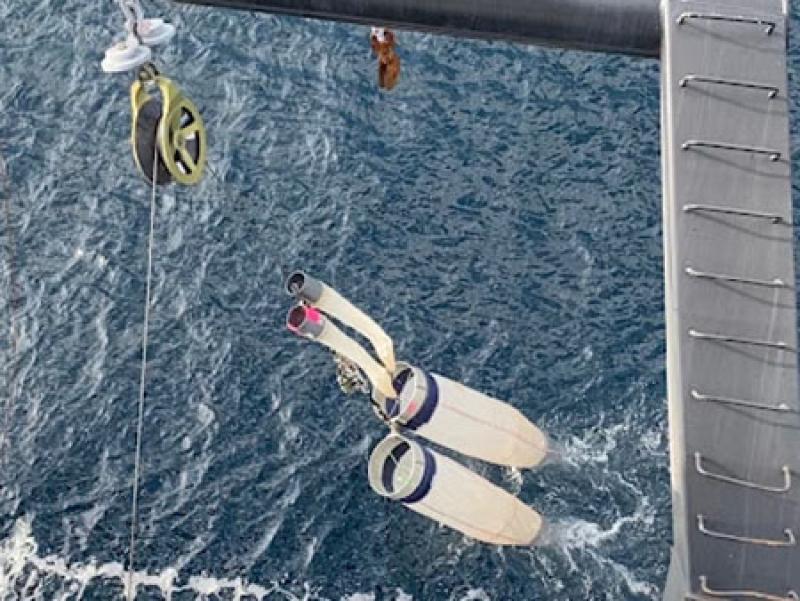During the 2021 fall Ecosystem Monitoring (EcoMon) cruise, researchers completed 89 stations aboard NOAA Ship Pisces. They achieved near-complete coverage of the survey area from north of Cape Hatteras, North Carolina, to Cape Cod, Massachusetts. They completed less than 25 percent of Georges Bank and the Gulf of Maine stations. They dropped many of these stations, which were north of Cape Cod, due to fewer available sea days than originally planned and strong fall storms. The cruise was completed in 11 days, beginning October 15 and ending October 26.
Samples of zooplankton—some tiny animals, and other very young stages of some animals that will grow larger—provide information about the food chain supporting fisheries and marine mammals. Scientists use larval fish and egg samples to learn more about fish stock spawning and help estimate stock abundance. Measurements of physical and chemical conditions like temperature and salinity help us describe ecosystem productivity, spawning, larval recruitment, fish condition, and species distributions.
Together, the core measurements conducted by our EcoMon cruises help researchers understand and predict changes in the Northeast shelf ecosystem and its fisheries. Researchers are scheduled to sail on the next EcoMon survey in the spring of 2022.
Core Sampling Summary
Plankton Collection
Core EcoMon sampling includes “bongo” net tows to collect zooplankton, larval fish, and fish eggs. These fine-mesh nets are attached to side-by-side steel rings, resembling bongo drums when deployed. During this survey, bongo net tows were conducted at 77 stations. Samples from this survey will be used to update an index of plankton forage for the 2022 State of the Ecosystem report.
Conductivity, Temperature, and Depth Profiles
Seawater conducts electricity. This “conductivity” varies by depth and other oceanographic factors, and is used to estimate the salinity of seawater. At all 89 stations, the crew deployed an instrument that can measure conductivity, temperature, and depth. The combination of temperature and salinity at various depths helps define marine habitat boundaries, track ocean circulation, and monitor changes in climate. This can help explain changes in marine species distribution and productivity.
Ocean Acidification Monitoring
To monitor marine carbon cycling and ocean acidification, scientists collected water samples that will be analyzed to measure dissolved inorganic carbon, total alkalinity, pH, and nutrients at 22 stations. Increases in dissolved carbon dioxide can increase acidity of the water, which can in turn affect shellfish and other organisms that are particularly sensitive to the acidity of ocean water.
Special Collection Summary
Our EcoMon program collaborates with other agencies and institutions to support research that enhances core EcoMon sampling. While COVID-19 mitigation protocols limited external participation on this survey, the fall 2021 EcoMon cruise included sampling for several ongoing projects with external partners.
Pteropods
Researchers collected pteropods, a planktonic shelled mollusk, from the water column. The condition of the pteropod shells will be examined to measure the biological effects of ocean acidification. This work is being conducted in partnership with the Bermuda Institute of Ocean Science, where the measurement technique was developed by Dr. Amy Maas.
Marine Life
Two observers were aboard to watch for and record data on seabirds, marine mammals, and sea turtles encountered along the cruise track. This is part of the Atlantic Marine Assessment Program for Protected Species, a partnership among scientists from NOAA, the U.S. Fish and Wildlife Service, the Bureau of Ocean Energy Management, and the U.S. Navy.
Plankton and Phytoplankton
An imaging flow cytobot was deployed aboard the ship and used to image and count phytoplankton cells continuously from surface waters during the ship’s transit. This work is part of a National Science Foundation project, the Northeast U.S. shelf Long Term Ecological Research. It is led by Woods Hole Oceanographic Institution with collaborators from the University of Massachusetts Dartmouth, the University of Rhode Island, Wellesley College, and NOAA Fisheries. Scientists also collected plankton samples for this research effort and for Census of Marine Zooplankton genetics studies.







